#>implying literary devices aren’t important in a plot and character driven story
Text

Webtoon readers are dumber than rocks
12 notes
·
View notes
Text
Symbolism Over the Garden Wall

It’s hard to make it through an English class without talking about symbolism at least once. In my own high school experience, we studied this literary device in-depth using Hawthorne’s The Scarlet Letter. I remember hating the unit because I didn’t care about the general plot of the book at all. As a result, I also didn’t care about exploring the symbolism within.
One of the fastest ways to kill someone’s interest in a tough topic like symbolism is to set them up with a novel they end up hating. So instead, let’s explore this element through pop culture in order to get a better understanding of it and how authors use it to enhance the stories they craft.
Many literary techniques (including this one) lend themselves well to mediums outside of text-based mediums like novels. You can find them in comics, cartoons, movies, video games and even in paintings. For simplicity, I’m mostly going to use the words “author” and “creator” interchangeably to speak about the brilliant minds behind these works, but keep in mind that this applies to any storyteller in virtually any medium.
In order to gain a deeper understanding of this literary device, let’s focus on the 2014 Cartoon Network miniseries Over the Garden Wall. This delightful miniseries contains a lot of great examples of symbolism in its 10-episode run.
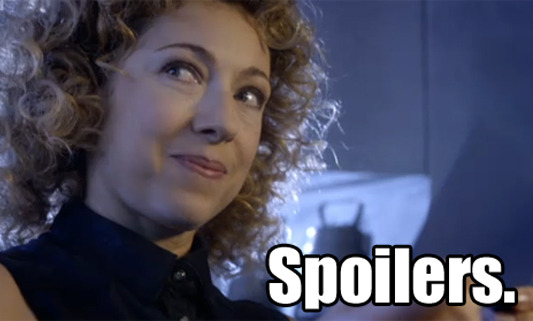
Spoiler Alert: If you have not experienced the pleasure of watching Over the Garden Wall in its entirety yet and plan to, I recommend that you stop reading this exploration and go watch it right now! Serious spoilers ahead! Watching Patrick McHale’s imaginative work for the first time is a fun ride, and I don’t want to spoil it for anyone.
Having said that, let’s begin.
What is Symbolism?
Before we can delve into an analysis of Over the Garden Wall using symbolism, we need to define it. In it’s most condensed form, let’s call it “the use of symbols to signify ideas and qualities by giving them symbolic meanings that are different from their literal sense.” That definition comes from Literarydevices.net, a handy website for all of your literary device needs.
In other words, authors take an idea or feeling and represent it with a person, place, or thing. It’s a way to liven up your writing, and offers creators fun ways to give a wink to the discerning reader by giving them additional insight to better enjoy the work with.
Movies use this device frequently. Ever notice that rainy scenes in movies such as Mulan or The Hunchback of Notre Dame often pop up during sad moments? Likewise, if you see a picture of a dove at a rally, you can recognize it as a peace rally. Nobody told you. You just knew somehow. We know things like this without being told because these are common symbols. Rain popularly symbolizes sorrow, and doves symbolize peace.
Symbolism Vs. Metaphor
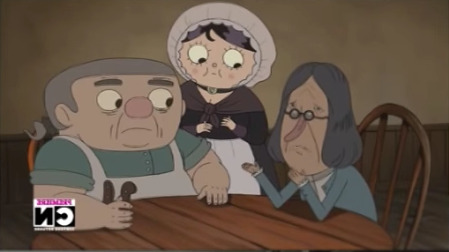
Make sure that you don’t confuse symbolism and metaphor. Symbols are specific objects, seasons, animals, or characters (pretty much any noun) that represents something else, often throughout a work (but not always). Metaphors tend to be a lot more short-term, comparing two unlike things for the sake of making a point. An example might be “your eyes are the deep blue sea,” which makes the point that someone’s eyes are extremely blue and seemingly endless, but doesn’t cause their eyes to represent a concept or idea. Some metaphors do run a bit longer.
Common Symbols
In order to easily convey ideas without directly stating it in their writing, many creators use common symbols that already have a widely recognized meaning attached to them. The appearance of a dog often symbolizes friendship and loyalty, a flood of light might signify understanding or goodness, and winter represents death (remember this one for later!). These symbols are easily recognizable to a wide range of readers.
Take a look at this example: you’re enjoying your favorite novel or comic, when you come across a character “with a fire always blazing in their eyes.” You know that they do not literally have fire burning in their eyes every time you see them (that would hurt!). Instead, you search your stored knowledge of symbolic meaning (either the knowledge already in your brain, or what you found in a dictionary of common symbols and realize that the fire in this person’s eyes may represent ferocity, determination, anger, or evil. Which one does it represent? Well, you just need to keep reading and find out! The character’s actions will show you more about what that fire means.
These common symbols make it easier for writers to get meanings and concepts across without the need to develop a new symbol that their reader needs to figure out. Unfortunately, that does mean that when you first start exploring this device, you may find yourself frequently looking up the common meanings.
A few popular ones include:
Dogs: loyalty, friendship, obedience
Wind and storms: turbulent or violent (negative) emotion, adversity
Water: cleansing, origin of life, regeneration
Purple: royalty, wealth
Oak trees: strength, wisdom
Rose: budding youth, romance, potential, fragility, beauty
Specialized Symbols
What often makes this literary device complicated for beginners is that authors create new symbols in their works that hold meaning only within that work. Additionally, that symbol might have a deep life lesson attached to it, or it might just symbolize something important to fully understanding the characters or story. These symbols don’t retain that meaning when the same object appears in another story. (Love Rise of the Guardians? Keep an eye out for a post on a specialized symbol from the film, coming soon!)
Sometimes, creators directly state the meaning of a specialized symbol. You will see examples of this shortly. Other times, they only imply what it stands for. You can figure out the meaning by analyzing the scenes in which it appears and how characters interact with it.
You Know What They Say About Beauty and the Eye of the Beholder
Many times, audience interpretation of a symbol differs widely. A person’s own personal experiences might change how they view a symbol. Cultural background also changes the meaning of symbols.
In a similar way, applying different literary lenses can change the meaning of symbols as well. We aren’t going to delve into that labyrinth right now, though! That’s an easy place to get lost, and we don’t have nearly enough time to explore symbolism AND literary theory.
Is symbolism always intentional? I don’t believe so. I think that sometimes, authors include items in their stories that have specific meaning to themselves, or serve a specific purpose in the story, and the audience finds their own meaning in it.
Let’s Try It!
Got all that? Awesome! Let’s further explore this literary device by taking a look at Over the Garden Wall.
If you want to try your hand at figuring out a few of the symbols in the miniseries yourself first, go watch it again and analyze these symbols as they appear: seasons, the price of a ferry ride, the Dark Lantern, Edelwood trees, and the Beast. Come back and see how you did!
Seasons

Let’s start with a common one. If you’re somewhat familiar with this literary device, you might have picked up on the symbolism of the seasons (which hint at what’s happening to the brothers long before the 9th episode reveal). We meet our heroes wandering the woods in fall. In fact, most of the show takes place in the fall, only turning to winter in the last few episodes as everything quickly goes from bad to worse. (Here is your final spoiler warning. There is no turning back after this.)
Fall, the waning of warm growing seasons, commonly represents the waning of life. It comes into play when a character nears the end of their days. This winds up being true for the brothers, who are unknowingly drowning as they wander the Unknown.
In Babes in the Wood, fall gives way to winter when Greg strikes out on his own to face the Beast after Wirt runs out of hope. At this moment, the boys find themselves locked in a losing battle with death. Winter commonly represents death, the closing of life. If you made it to the end of the last episode and wondered what would have happened if they did not defeat the Beast, wonder no longer.

The Price of a Ferry Ride
There’s another symbol that hints at what is happening to the boys long before the audience becomes privy to the events of that Halloween. Remember when Beatrice convinces them to visit their dear old Unkie Endicott? They need money to ride the ferry so that they can get to Adelaide’s house.
Needing money to ride a boat isn’t particularly enlightening, until you examine the amount of money they need. A ferry ride costs two cents. Two coins, which they earn from Mr. Endicott.
Fans of Greek mythology might notice an ominous connection between this and the price of riding across the River Styx. In Greek mythology, the dead require two coins in order to cross the River Styx and enter the land of the dead. People laid coins on the eyes of the deceased so that they could pay the boatman.
In the end of this comedic adventure, Greg throws their coins into a deep fountain, and they sneak onto the ferry instead. It makes you wonder, did Greg’s poorly planned act of defiance save their lives?
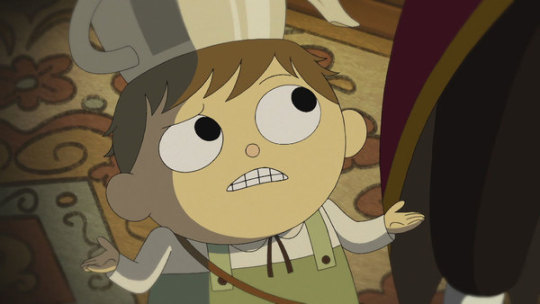
BONUS: This is also an example of an allusion, which is a reference to people, places, events, and even other works and ideas.
The Dark Lantern
Now, let’s take a look at a symbol specific to Over the Garden Wall: the Dark Lantern. The lantern represents blind belief driven by hope. We don’t discover this meaning until the fourth episode, but looking back, we can see evidence of this from the beginning.
We first see the lantern in the possession of the Woodsman. He calls it his “lot in life, [his] burden to bear,” explaining to the brothers that he walks the woods finding Edelwood trees to keep it lit. He sounds like he hates this task, which makes it easy to wonder why on earth he keeps doing it every day if it’s such a burden. We get the sense that something drives him to do so, but we don’t know what.
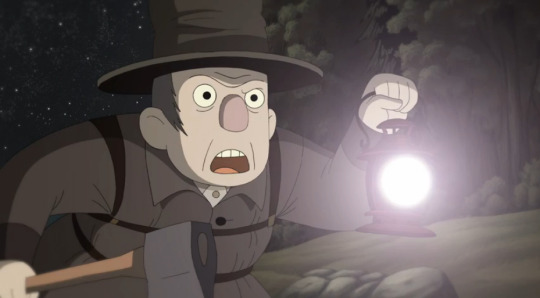
The answer doesn’t appear until the end of episode 4, Tales of the Dark Lantern, when the Beast reveals that it contains the soul of the Woodsman’s daughter. At this point, we can determine that the Woodsman burns Edelwood to keep the lantern lit in order to preserve his daughter’s soul. But the details surrounding this are a little unclear. Will preserving her soul eventually lead to something, or does he just try to keep her soul going without any hope beyond that? Viewers might also wonder how the Woodsman knows that it contains her soul at all. Anyone who has read the comics released after the original airing know the answer to this one. He believes simply because the Beast told him so. He has no other evidence.
At this point, the lantern develops its symbolic meaning of blind belief driven by hope. The Woodsman blindly follows the belief that keeping it lit will protect his daughter’s soul, and he doesn’t appear to have a plan beyond simply keeping it lit.
Fast-forward to the ending of the tenth episode, The Unknown. Here, we see Wirt faced with a choice: let his brother die, or take on the job of lantern bearer and keep Greg’s soul safe in the same way that the Woodsman tried to preserve his daughter’s soul.
At first, it seems like Wirt will accept this task to save his brother. But he isn’t the kind of person to blindly follow hope. He’s proven himself to be the kind of person who either gives up entirely, or presses on and succeeds through pure muster. Given this, taking the blind hope offered by the lantern isn’t even a real option for him. He immediately questions this salvation offered by the Beast, and realizes what is really happening with that lantern in a way that the Woodsman could not.
After declining to follow hope blindly, Wirt finds the strength to free his brother and leave the forest. He also returns the lantern to the Woodsman, giving the man the option to continue following blindly or to move his life forward. The Woodsman, having seen someone else do the same, finally finds the strength to surrender his burden. Leaving behind the futility of preserving the lantern’s flame frees the Woodsman and allows him to return to life, where he finds an unexpected surprise waiting for him.
Sometimes, symbols hold more than one meaning within a work. In the fourth episode, before we learn about the trapped soul, we find out that the people at the inn all associate the Dark Lantern with the Beast. They say that whoever holds this item becomes the Beast. This shows that to the characters, the lantern symbolizes the Beast, a dark entity that they may not fully understand, but everyone knows to fear.
BONUS: Symbols can also show a parallel between two elements of a story in order to give the audience a deeper understanding of what’s really going on. There’s a great example of this in the first episode. The Woodsman calls the lantern his lot in life, his burden to bear. At the end of the episode, he tells Wirt that while the lantern is his burden, finding a way out of the woods is Wirt’s.
Knowing that the lantern represents blind belief driven by hope, we can conclude that Wirt’s search for a way to get out of the woods is equally futile and blind. Wirt possesses no knowledge of what will happen when he gets out of the woods; he simply wants to get out. As long as he focuses solely on this task, he can’t find the exit and runs into one deadly obstacle after another.
Edelwood Trees
The Edelwood trees are a more straightforward symbol, once we learn that they are the souls of people (specifically children, but we can presume that they can be anyone given how nervous the Beast makes the people at the inn) who have lost all hope and taken root in the woods. Thus the Edelwood trees represent lost hope.
These trees serve as fuel for the Dark Lantern. Looking at the symbolic meaning, lost hope can fuel blind belief driven by futile hope. The Woodsman lost his hope of reclaiming his daughter from the Dark Lantern long ago. As a result, he feeds it lost hope in order to perpetuate his scrap of hope that he can sustain her soul forever.
The Beast

As mentioned earlier, symbols go beyond objects, seasons, or animals. They can also be characters. The Beast symbolizes surrender after losing hope, which I’ll call despair for simplicity. His one objective throughout is to cause people to lose hope in order to keep his flame lit. He subsists on lost hope.
At the end of The Old Grist Mill, the Woodsman tells the brothers more about the Beast. He says “the Beast cannot be mollified like some farmer’s pet. He stalks, like the night. He sings like the four winds. He is the death of hope. He steels the children. And he’ll rule…”
The man’s despondent description pretty accurately depicts despair in real life. People can’t just magic away such a deep, painful emotion, despite popular belief to the contrary. It sticks with a person, often crushing any other positive emotions that try to worm their way in, effectively snuffing out any other hopes that that person carries. Additionally, despair seems to lurk everywhere, just waiting for someone to come along for it to cling to. For some, this happens as a result of a painful event in their lives, and for others, it comes alongside things like depression or PTSD.
Pulling it All Together
Figuring out the symbols is just half of the work. Next comes the critical thinking part, or the analysis. The audience can combine what they learn about the symbols with events in the work to pull together a lesson, or just a deeper part of the story that gives them more details.
Analyzing Over the Garden Wall, it can be said that the show demonstrates the cost of blindly believing in something you desperately want to be true. People need hope, but that hope often needs to be realistic to some degree. When people blindly follow something that they want to be true like the Woodsman, they block out parts of their lives and risk falling into an unending rut. Similarly, not having any hope can lead people to sad existences, and often times sad endings as well. A person might not literally turn into an Edelwood tree, but the real life consequences are pretty similar.
Ultimately, Wirt and Greg find their way out of the woods because they manage to break away from blindly following a path because they hope something good will come of it, and manage not to lose their own hope in the process. If they did not overcome these obstacles, they likely would have drowned.
But Wait, There’s More!
One of my favorite things about literary analysis (and perhaps what can make it difficult to figure out at first) is that there are usually multiple ways to interpret symbols and meanings within a work. As long as a person has sufficient evidence for their claims without outright ignoring other elements of the work, they could argue a completely different point than the person before them.
Let’s do just that!
I have one more symbol for you, and looking at this symbol could change our analysis of the story.
The Garden Wall
The title of the show gives us a great example of symbolism as well. The 10 episodes don’t really make it clear where the title of the show comes from. Sure, Greg and Wirt jump over a wall on their way to Potsfield, but it isn’t a garden wall. Similarly, they dive over a high wall to escape the police officer, a move that ends up starting their journey into the Unknown, but this isn’t really a garden wall either (though an argument for this being the garden wall can be made, which I do address later). So where does this garden wall come in?
The comics can help provide an answer to this. If you have not read these yet, I highly recommend them. In these playful comics, we learn more about the Woodsman’s story, and find out just why he believes the Beast’s lantern contains his daughter’s soul. But I’m not here to spoil that for you. Instead, I want to take a look at the life he shares with his daughter before tragic events lead into the situation we see in the animated miniseries.
They live in a comfortable little cabin in the woods which they work hard to maintain. A garden wall rings the cabin to mark the boundary of their property. The wall also becomes a boundary for the Woodsman’s daughter when she is told not to go beyond it, showing her the limits of her explorable space outside of the cabin in order to protect her from the dangers that lurk beyond.
Many families create similar boundaries with their children in real life. Parents often set limits on where their kids can go in order to protect them from dangerous unknowns. For children growing up with walls around their family gardens, the garden wall often becomes that boundary. Everything on the other side of that wall is mystery, wonder, fear, unknown. Sound familiar?
Given this, the title turns the series into an exploration of this childhood unknown beyond that safe home boundary and all of the perils that may lie therein.
Adding this symbol changes our analysis a bit. Now, we could say that in Over the Garden Wall, we see what could happen when someone journeys beyond the boundaries of their world. That person may encounter hardships that they have no reference for handling, and need to respond accordingly.
If they start blindly following a path with the hope that things will get better with no proof that they will, nothing will change for that person and they may be ruled by despair. Similarly, if they let themselves lose hope completely, they will be consumed by despair. Only by finding a balance between recognizing false hope and maintaining hope can that person ultimately overcome the hardship and continue forward.
Both analyses are pretty similar, but ultimately have different meanings depending on what the viewer picked up on and felt most strongly about.

BONUS: The title of the show can also be seen in this way: In Into the Unknown, we see Wirt and Greg enter a cemetery called the Eternal Garden. From there, they jump over a wall to escape the police officer that drives in to investigate the “witches gathering” and accidentally frightens off all of the kids. The other side of the Garden’s wall ultimately leads them to falling into the water and nearly drowning. This does not diminish the symbolic meaning of the wall as a representation for the barrier between known and unknown, but it does create an object within the show to pin the symbol to.
I Challenge You (But Not to a Duel)!
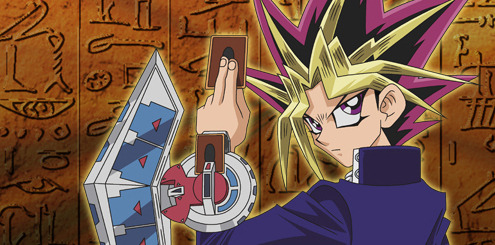
Enjoyed learning about symbolism? Ready to try it yourself? Good!
I highly recommend checking out one of these great stories and trying your hand at analyzing symbols. I’ve highlighted a few symbols in each example to focus on, but didn’t list them all. Keep your eye out for others within the story if you want to up the challenge level!
Good luck, and no cheating! Share your experience in the comments below.
Ender’s Game: Games
Harry Potter and the Sorcerer’s Stone: Wands (and no, I don’t mean…), the Sorting Hat, the Sorcerer’s Stone
Percy Jackson: The Lightning Thief: Games
Hunger Games: The 13 districts, tracker jackers, sunflowers
Starwars: Clothing (specifically, Luke’s and Vader’s)
Halflife: Freeman’s crowbar
Tangled: Color symbolism (look at their clothing colors), the mobile above her crib (especially the bluebird)
Wall-E: The plant, the Lido Deck, and the Hello, Dolly VHS
Mass Effect 3: The little boy (you know the one)
Portal games: Cake (this symbol transforms throughout the story!)
The Scarlet Letter: Light and darkness, the scarlet ‘A’ (this symbol transforms too)
Lord of the Flies: The conch shell, the Beast
Gathering Blue: The color blue
Their Eyes Were Watching God: Janie’s hair, plants, seasons
Have a favorite game, comic, show, movie, or book you’ve found symbolism in? Share it in the comments! You can also connect with me on Twitter at @Popliterature, or send me a note!
And as always, if you have a literary device you want to know more about, or a game, comic, show, or movie that you want to see make an appearance on the blog, leave a shout-out in the comments!
#over the garden wall#literature#literary study#pop culture#pop culture literary tutor#symbolism#what is symbolism#literary device#english class help#english class#language arts class#language arts#i love books
3 notes
·
View notes